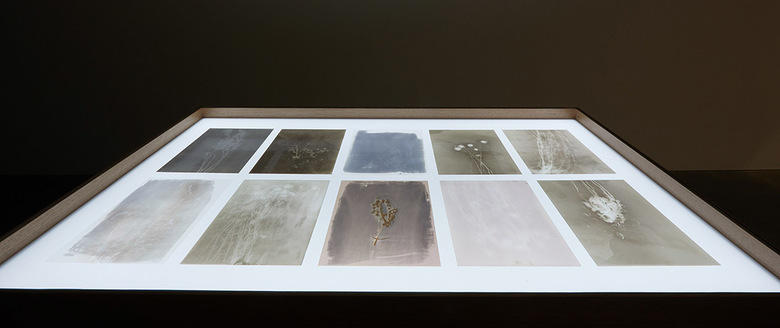
Amanda Williams, Phytograms (High Plain, Great Dividing Range),
2023, unique phytogram on expired Agfa orthochromatic film, light box, custom plinth, 10 phytotypes, each 30 x 24 cm, installation dimensions variable, TCG22778
(photo: Jenni Carter)
exhibition text
This installation offers another impression of the landscapes of the Alpine National Park in Victoria and Kosciuszko National Park in New South Wales, the subject of Amanda Williams' large format black and white photographs in the adjacent room. To make this work, the artist used the phytotype technique, a camera-less photographic process first developed in the 19th century involving the chemical interaction between plants and light-sensitive material. Williams exposed her film in the environment to make these phytotypes. The resulting images emerged from the chemical reaction between organic matter and the light-sensitive gelatin silver emulsion of the film. The objects recorded, such as plants, soil or rocks, made a direct 'print' or impression on the negative. This light-sensitive material became the final work.
I hope this experimental process offers another 'view' of the landscape and an insight into material process, the materiality of film and light sensitivity. Importantly, the images offer the viewer direct impressions of the landscape I experienced. Conceptually, the fugitive nature of the process, the uncertainty of final outcomes and the unstable nature of the unfixed surface of the negative — a surface that continues to change over time — mirrors the ecological instability of these alpine landscapes, and the contested histories the landscape bears witness to. I have also worked against traditional methods of 'fixing' the negative, allowing the negatives to continue to change over time. The Image Is not a frozen moment. It is a continuously unfolding moment.
— Amanda WIiiiams
- » installation view: The National 4: Australian Art Now, Museum of Contemporary Art Australia, Sydney, 2023 | showing Amanda Williams, Phytograms (High Plains, Great Dividing Range), 2023
- » installation view: The National 4: Australian Art Now, Museum of Contemporary Art Australia, Sydney, 2023 | showing Amanda Williams, Phytograms (High Plains, Great Dividing Range), 2023
- » Amanda Williams, Phytograms (High Plains, Great Dividing Range), 2023 — detail 1
- » Amanda Williams, Phytograms (High Plains, Great Dividing Range), 2023 — detail 2
- » Amanda Williams, Phytograms (High Plains, Great Dividing Range), 2023 — detail 3
- » Amanda Williams, Phytograms (High Plains, Great Dividing Range), 2023 — detail 4
- » Amanda Williams, Phytograms (High Plains, Great Dividing Range), 2023 — detail 5
- » Amanda Williams, Phytograms (High Plains, Great Dividing Range), 2023 — detail 6
- » Amanda Williams, Phytograms (High Plains, Great Dividing Range), 2023 — detail 7
- » Amanda Williams, Phytograms (High Plains, Great Dividing Range), 2023 — detail 8
- » Amanda Williams, Phytograms (High Plains, Great Dividing Range), 2023 — detail 9
- » Amanda Williams, Phytograms (High Plains, Great Dividing Range), 2023 — detail 10







